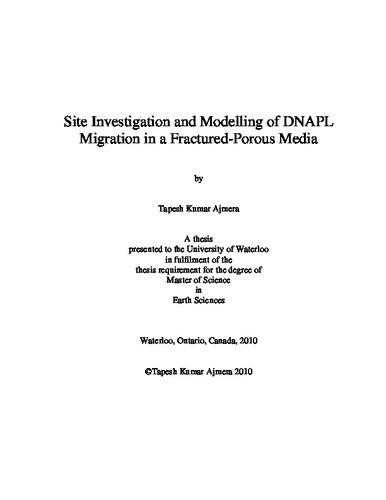| dc.description.abstract | The present work is in the area of site and computational investigations dealing with migration of a dense non-aqueous phase liquid (DNAPL) within a discrete fractures network embedded in a porous rock media at field scale using numerical simulation. The migration of DNAPL in the subsurface is dependent upon surface parameters, subsurface aquifer parameters and other subsurface conditions. Generally, these aquifer parameters govern the temporal and spatial variability of a DNAPL. To understand the source zone architecture and dissolved plume movement in the subsurface, characterization of these relevant subsurface parameters is required with respect to space and time. The present study focuses on a systematic investigation and characterization of fluid and transport parameters at highly contaminated fractured-porous media site located at Smithville, Ontario, Canada.
Data used to characterize the Smithville site include site geology, ground surface elevation, historical hydraulic head, hydraulic parameters from packer tests such as hydraulic conductivity, porosity, analyses performed on borehole core samples, pumping rates from recovery wells, and contaminants transport parameters such as DNAPL concentration data. Geostatistical and statistical analysis have been used to generate information on groundwater flow direction, vertical hydraulic gradients, contaminant plume migration and source zone architecture. TCE concentrations and pumping rates have been used to estimate TCE mass removal from the site. Important parameters for use in the multiphase model have been developed, including capillary pressure curves and relative permeability curves for rock matrix and fractures, and pore throat radius of the rock matrix.
DNAPL behaves differently in fractured-porous media than it does in porous media. To understand DNAPL behaviour in fractured-porous media, site specific conceptual model development to describe geological, hydrogeological, fracture network, and DNAPL occurrence is required. Prediction of the impact of source mass depletion at highly contaminated fractured-porous media site for achieving regulatory goals, as a contaminant concentration at a down gradient compliance boundary was evaluated using multiphase compositional model CompFlow. The results demonstrate that a large amount of non-aqueous phase DNAPL is present in the Vuggy Dolostone and the Tight Dolostone (23-28m, Low Vinemount) and a small amount is present in Permeable Dolostone (Eramosa). The peak concentration at the compliance boundary is much greater than the maximum acceptable concentration (MAC) for TCE of 0.005 mg/L for drinking water. | en |

